A Studied Approach at WiFi – Part 2
Peter Grace
Welcome back to my series on WiFi. In Part 1 of the series, I began with some basics of RF and explained some differences about antennas. It should be apparent at this point that there is a science behind this activity, and I’ll take this moment to warn you thoroughly before we move on: These posts are a good way for you to become familiar with WiFi and should provide you with some solid knowledge to help improve your WiFi coverage. However, this brief education is not a replacement for having an actual RF engineer do a site survey of your environment! If you have a “must work right the first time” environment, and you’re reading this because you’re the decision-maker and don’t have the slightest hint about what all this is about, Get An Expert. They do this all day long. It’s money well spent.
If you do use these techniques below, Your Mileage May Vary. It’s also important to note that if you go to all this work, setup your access points, then your neighbor goes and installs his AP right next to yours on the same channel, then you’re going to be stuck re-doing these activities all over again. WiFi isn’t a static situation; as people get more WiFi-connected devices, the playing field changes, and it will change on you, I guarantee it.
Understanding RF Interference and What It Does to WiFi
You hear people joke about microwave ovens interfering with WiFi equipment pretty often. Most people laugh it off as an urban legend. It’s not. Below, I have included some RF spectrograms for your entertainment. If you haven’t seen images like this before, they are a visualization of signal frequency and intensity over time. Past-to-present is a top-to-bottom relationship, and the colors are a heatmap (with red being a strong signal.) As you look at both types of graphs, the channels start from 1 at the left hand side of the graph, and go up through 12 in the right hand side. NOTE: Quick Shout-Out to the guys at metageek.net for creating the awesome Wi-Spy and accompanying Chanalyzer Pro software. We paid full price for the DBx bundle (Comes with the Wi-Spy DBx and Chanalyzer Pro) and I definitely feel like it was money well spent. Check them out if you want to do these types of visualizations yourself.
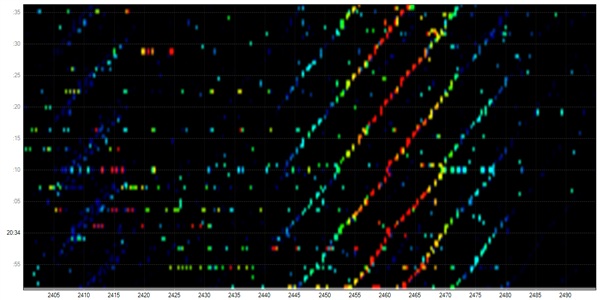

These images show what the wireless signal looks like in my suburban home. Not a lot of interference in this visualization, you can see my home Cisco Aironet 1240 AP humming along happily as visualized by the wavy lines in the waterfall spectrogram, above. In the lower graph, we see signal strength (Amplitude) measured by frequency.
Let’s shake things up, and show what happens when you fire up a microwave oven:
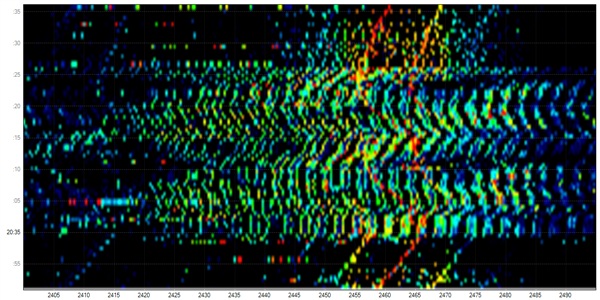
Look out, here comes that microwave burrito exploding all over your RF Spectrum! For about 30 seconds, I nuked a mug of water and this was the result. You can see through the swamp of RF that the access point does its best to compensate for the signal interference, but that’s a pretty strong blast of RFI.
Do you have a baby monitor at home? Is it on 2.4ghz? Ready to see what it’s doing to your wireless signal?
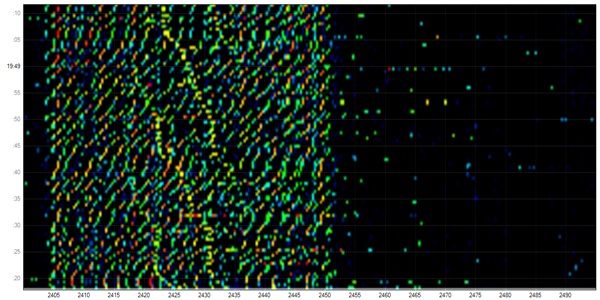
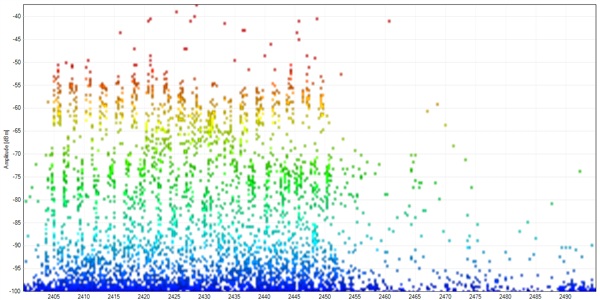
These two charts were captures I took from my friend’s house (incidentally, the gentleman who I mentioned in the previous post — he has a penchant for wifi problems.) I was over his house and ran some traces to get a visualization of his wireless conditions in preparation for installing a new wireless router. I asked him if he noticed the WiFi being slower at night and he’d mentioned that it did indeed seem to be more problematic at night. Welcome to the wonderful world of random equipment in your home causing issues with your wifi. In the above trace, you can see the telltale wavy lines of the access point, trying to power its way through the interference. The graph below has just the slighest hint of bell curve, which is where his AP was situated in the RF Spectrum. I believe in this case his AP was on channel 3. Needless to say, we popped his new wifi router on channel 11, which is quiet in these graphs.
One final graph to show. If you scroll back up to the initial image I showed of my suburban home, this will give you an idea of what your general household’s 2.4gHz spectrum might look like. Now, compare that image to this:

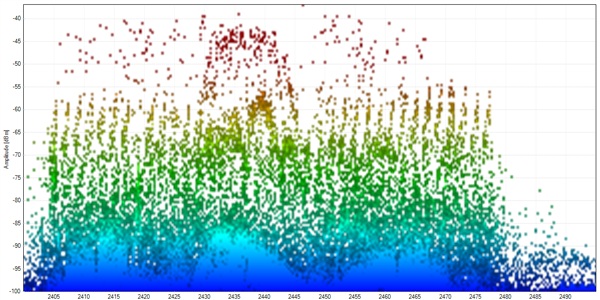
This, my friends, is what the 2.4gHz spectrum looks from the Stack Exchange offices. We’re located down by Wall Street, on the 26th Floor of One Exchange Plaza. Our scenic vantage point does come with a cost! These spectrograms show just how much RF interference we are subject to at this location. Astute readers may notice the timescale difference on the graphic, but I assure you that the 30 second view is just as nasty.
What can we take away from these charts? One could safely summarize this entire section as “Location and the gadgets in your home both play a significant role in how your WiFi might perform.”
Mapping Your Wireless Landscape
It’s worth noting that even though the above charts were taken using a very expensive measuring tool, your laptop’s WiFi card is a potent ally in your quest to improve your coverage. For the next section, I am assuming that you firstly are running Windows and have downloaded and installed both Vistumbler as well as Microsoft SQL express. I am aware that a strong number of our readership are Linux based, and there is also a big Mac contingent. I’ll unabashedly say that the steps I’m following and the software choices I made were purely for my convenience, but I hope that I explain the process in easy enough terms so that the tinkerers out there can take the wheat from the chaff, so to speak.
Step 1 – Take some measurements!
Vistumbler is a wardriving utility that, when attached to a gps, can help you map where there are wireless access points in range of your device. We’re going to borrow it for a more sedentary purpose. Fire up Vistumbler, set your laptop in the areas where you want to consume your WiFi signal, and then start the scan/capture process. Leave the laptop there for at least 30-60 minutes, as we want a whole lot of datapoints to work with. It will keep track of every time it hears of an access point and record the relative strength of the signal. Once the time is up, you can either run the detailed export to CSV now, or “Exit (Save DB)” and come back to export the file later. NOTE: If you’re in a tight urban region like we are at Stack Exchange, leaving Vistumbler up for 30+ minutes will result in a tremendous amount of data! It’s wise to have a very powerful PC to handle the vistumbler export process, or do seperate scans and aggregate the data together in a later step.
Step 2 – Massage the data!
Sadly, Vistumbler’s export to CSV does leave a bit to be desired with its field quoting. We’re going to open the csv in Excel, since it seems to be especially forgiving. Once we’ve opened it in Excel, we’ll do the following steps:
- Make a new column for Location. Populate the column with a location name. You’ll want this when you’re querying SQL later on.
- Save the file as an Excel spreadsheet.
- Fire up SQL Server Management Studio.
- Create a new database if you don’t already have a good scratch database, then right-click the db and select tasks->import data.
- Using “Microsoft Excel” as a datasource, submit your new excel file as the source data. HINT: If you’re getting an error about unable to find a particular OLE provider, and you’re on 2010 like me, with 64bit windows, you will likely need this link to load said provider.
- Select the destination database; elementary stuff here. From this point on, “Just Keep Hitting Next,” except for the prompt where you specify the destination table name. I strongly advise you to change that name to something easier to type rather than the default date/time string. Finally, Finish to start the import job. This may take a while, so don’t be afraid if it seems like it’s taking too long.
- Repeat these steps for each file of data. Be sure to specify the same table name for each import, it will append to the database.
Step 3 – Analyze!
With this complete, congratulations! You now have data in a sql server that you can use to leverage the power of SQL to get some statistics from. I’ll admit I’m a SQL neophyte — I can do some joins and “GROUP BY”s but I’m sure others could tease a lot more information out of it than I have. Here are some basic queries for your dataporn pleasure:
Get a sorted list of strongest access points across all locations:
select LOCATION, SSID, AVG(SIGNAL) AS AVGSIGNAL
FROM [dbo].[wifilog]
GROUP BY LOCATION,SSID
ORDER BY AVGSIGNAL DESC
| LOCATION | SSID | AVGSIGNAL |
| sysadmin | SO-GUEST | 90 |
| cantremember | SO-GUEST | 89.7431436154527 |
| cantremember | NULL | 73.9324583394779 |
| cantremember | ROVIO | 70.6069006192864 |
| sysadmin | ROVIO | 69.875 |
| sysadmin | NULL | 61.5 |
| sysadmin | hpsetup | 61 |
| cantremember | Grusslife | 60.2857564140372 |
| sysadmin | Grusslife | 59.5625 |
| cantremember | HPC7B114 | 55.2590909090909 |
In the above query, we see that in our sysadmin office, as well as somewhere in our office (for shame, I forget where I took the trace!) the strongest signals are SO-GUEST (our current guest wireless AP) and ROVIO (for our cute little mobile webcam.) We’ve also got a couple shadow AP’s (as specified by NULL) followed up by some other AP’s that I’m not sure who or where they are. Suffice to say, our current AP is pretty strong in these two locations.
Find the average signal strength of all APs at a particular location:
select SSID, AVG(SIGNAL) AS AVGSIGNAL
FROM [dbo].[wifilog]
WHERE LOCATION='sysadmin'
GROUP BY SSID
ORDER BY AVGSIGNAL DESC
| SSID | AVGSIGNAL |
| SO-GUEST | 90 |
| ROVIO | 69.875 |
| NULL | 61.5 |
| hpsetup | 61 |
| Grusslife | 59.5625 |
| Akin Law | 55 |
Similar to the first query, you can drill down by a particular location and see the top AP’s seen at that location. This is useful, but what we’re really looking for is the least used channels at a certain location.
Get a channel utilization chart
select LOCATION,CHANNEL,SSID,AVG(SIGNAL) AS AVGSIGNAL
FROM [dbo].[wifilog]
GROUP BY LOCATION,CHANNEL,SSID
ORDER BY AVGSIGNAL DESC
| LOCATION | CHANNEL | SSID | AVGSIGNAL |
| cantremember | 8 | NULL | 90.034808259587 |
| sysadmin | 8 | SO-GUEST | 90 |
| cantremember | 8 | SO-GUEST | 89.7431436154527 |
| sysadmin | 8 | NULL | 88 |
| cantremember | 11 | ROVIO | 70.6069006192864 |
| sysadmin | 11 | ROVIO | 69.875 |
| sysadmin | 6 | hpsetup | 61 |
| cantremember | 11 | Grusslife | 60.2857564140372 |
| sysadmin | 11 | Grusslife | 59.5625 |
The above gives us some pretty useful information. We can see here that channels 8 and 11 have several entries, and only one device in range of our scans is on channel 6. Using some critical thinking, it’d indicate that channel 3 might be a good choice should we want to add a new AP to this environment. Lets massage the query a bit to see if that’s confirmed by our other data:
select LOCATION,CHANNEL,SSID,AVG(SIGNAL) AS AVGSIGNAL
FROM [dbo].[wifilog]
WHERE CHANNEL in (1,2,3,4,5,6)
GROUP BY LOCATION,CHANNEL,SSID
ORDER BY AVGSIGNAL DESC
| LOCATION | CHANNEL | SSID | AVGSIGNAL |
| sysadmin | 6 | hpsetup | 61 |
| cantremember | 2 | NULL | 57.8348569743439 |
| sysadmin | 1 | cisco-voice-axiomSL | 55 |
| sysadmin | 6 | Akin Law | 55 |
| sysadmin | 1 | cisco-data-axiomSL | 55 |
| cantremember | 6 | Akin Law | 54.2220583898555 |
| cantremember | 2 | BLUESKY-NYC | 51.3716814159292 |
| sysadmin | 2 | BLUESKY-NYC | 51 |
| sysadmin | 1 | cisco-scan-axiomSL | 51 |
| cantremember | 6 | OpenWrt | 50.7345132743363 |
| sysadmin | 6 | OpenWrt | 50 |
| cantremember | 6 | EPAD | 49.154272517321 |
| cantremember | 1 | FGAwireless | 48.0518896220756 |
| sysadmin | 6 | EPAD | 48 |
| cantremember | 1 | cisco-voice-axiomSL | 47.982855143457 |
| cantremember | 1 | cisco-scan-axiomSL | 47.9389792899408 |
| cantremember | 1 | cisco-data-axiomSL | 47.4301110385369 |
| sysadmin | 6 | VX7E7 | 46 |
| cantremember | 4 | Corner | 45.3483043079743 |
At first blush, one might be enthusiastic about channel 3 given the fact it’s not used as the main carrier frequency in any of our entries. Be careful, though, for WiFi channels have some pretty strong overlap:
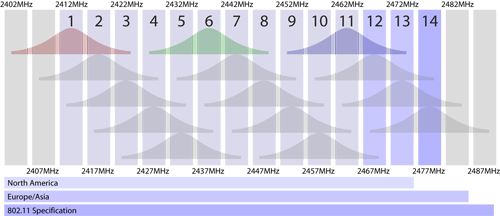
As this graphic shows, each wifi “Channel” is merely just a 5MHz swatch of the 2.4ghz ISM band. WiFi signals have a 22Mhz bandwidth, so realistically there’s only 3 channels one can use in an environment without any fear of interference or overlap. Because of this, one needs to take into account not only the channel but also the signal strength of potentially interfering access points.
In our case at Stack Exchange, there are just so many APs utilizing so many channels that we’ve ultimately decided to go with a Cisco controller-based access point layout, which will dynamically change channels based on signal conditions in realtime. For those of us at home, this is way too expensive of an option for most. Sadly, we’ll just have to take these data queries and give it our best shot.
I hope this blog series helps you a bit with your next WiFi installation. In summary:
- Antenna choice matters when you’re trying to cut through interference or travel long distances.
- Most residential building materials will not diffuse wireless signals to an appreciable amount unless you’re talking about very far distances, (i.e. trying to use your laptop on the third floor at the far side of your house when the AP is in the basement, for instance.)
- Be aware of electronics in your home that might share the 2.4GHz radio spectrum; they can seriously affect your wireless transfer rate and signal strength.
- Apps like Vistumbler can catalog used channels in your environment and you can then use this data to find a quiet spot in the spectrum.
As always, I welcome your comments and criticisms, below. Also, feel free to share any specific SQL queries you used that might help glean even more information from the datasets you’ve gathered!
-
Luis Teixeira
-
Peter Grace
-
-
Jeff Blaine
-
Peter Grace
-
-
Fynamo
-
Peter Grace
-
-
Kev
-
Chris Hearn
-
Peter Grace
-
Chris Hearn
-
-
-
Paul Weber
-
Peter Grace
-
-
Eli Lansey
-
Apollo Shockman
